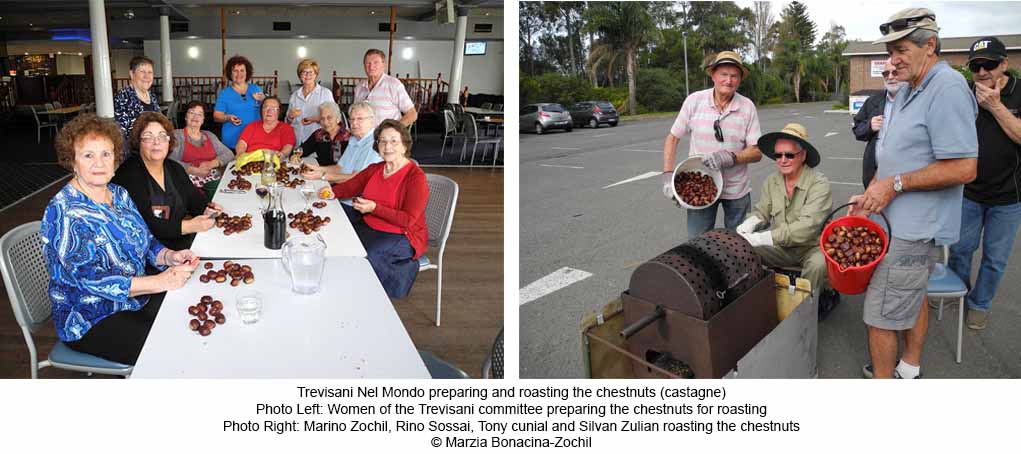How Castagne Day Got Started in Wollongong
Depending on what suburb you lived, what Italian community group you belonged to or your circle of Italian friends, there are different versions of how Castagne Day got its start in Wollongong. It didn’t start at the Fraternity Club, but after the ‘Frat’ took it on the Club has turned it into an annual event open to everyone and has grown Castagne Day to the main event that is celebrated each year in May. In the very early days of Castagne Day at the Frat a few of the Italian men and women members would volunteer their time; the men taking charge of the roasting, the women filling and serving the lolly bags. Sadly, many of these earlier volunteers are no longer with us, but Emilio Felli, aged 91 (as of May 2023) is still associated with Castagne Day and was instrumental in the creation and construction of the chestnut roasting barrel with his continual tweaking to improve his invention.

In 2003, the Migration Heritage Project’s “Celebrations: Spirit of Communities” Exhibition featured the tradition behind the roasting and eating of chestnuts. This Exhibition, curated by Linda Raymond, Museum Consultant & Interpretation Specialist, and through her interviews with members of the Wollongong’s Italian community revealed the following:
“At the Fraternity the Alpini cook the chestnuts – they are from the mountains. The Trevisani have Castagne Day at Mt Pleasant Rhododendron Park or ItSoWel (Italian Social Welfare Organisation) if it’s raining. Sant’ Andrea Irpinia have it at Port Kembla Community Hall.’ Turo Chiodo
The Alpini is a group of Italians who fought in the mountains during WWII. They are recognisable by their hats decorated with feathers. The Trevisani all come from the province of Treviso. The Sant’ Andrea Irpinia is group of Italians who all come from Sant’ Andrea, a town near Avellino that was devastated by earthquake over 20 years ago.
There are basically two types of Italian chestnuts: castagne (small and flat) and marroni (round, firm and large). Chestnuts are now grown in Australia and are available March-June. There are several varieties: Buffalo Queen, Red Spanish, Aussie Pride and Italian marrone types”.
Some people would roast the chestnuts themselves at home using their home-made chestnut roasters over an open flame BBQ, just because they liked “castagne”.

But how did this celebration get its beginning in Wollongong and end up at the Fraternity? Here is one version courtesy of Marzia Bonacina-Zochil.
In 1976 the Association of the Trevisani nel Mondo was formed in Wollongong. The members of the association were drawn from those who were from the city of Treviso in Italy and its small towns who now called Wollongong home. A few months after forming, the then President and Secretary of the association, (the late) Effrem and (the late) Giulia Bonacina learnt that Braidotti Fruits and Vegetables (now trading as Leisure Coast Fruit Market and Deli) was selling chestnuts (castagne). Eager to celebrate their Italian tradition, a small group of members consisting of Angelo and Carla Boccola, Guerrino De Lazzari, Pietro Girotto, Rino Sassai, Vito Torresan, Gerardo and Giovanna Visentin who were joined with a few others, purchased a large amount of castagne, set up a BBO in Stuart Park with the intention to roast the castagne. Improvising, the group drilled holes in a large frying pan to “roast” the castagne over the BBQ. Whilst there are many other Italian associations and individual members of the Wollongong community, it is believed this would have been the first ‘public’ roasting of castagne and it drew a lot of attention attracting passers-by with the aroma of freshly roasted chestnuts and the laughter emanating from the gathering, even resulting on one occasion with a visit from the then Lord Mayor of Wollongong who joined the festivities and sampled the castagne.

Many members of the Trevisani nel Mondo association continued to enjoy this yearly get togethers to roast the castagne and each year the number of participants grew and it became a very popular event for the Italian communities at Stuart Park. The large frying pan with holes could no longer cater for the growing numbers so Rino Sossai, with Giovanni Comacchio and a few members of the Alipini Association, another Wollongong based Italian association, fashioned a drum with holes with an ingenious turning mechanism to enable a greater number of castagne to cook inside, roasting them to perfection over an open fire.
Eventually the numbers grew so large that the Association of the Trevisani nel Mondo knew they had to look for another venue to accommodate the growing interest. Carla Boccola approached the Fraternity Club who agreed to hold the annual Castagne Day on club grounds and so what started out as a small group of Italians roasting a few chestnuts over a BBQ in Stuart Park on a large frying pan with holes, we now have a Castagne Day each year enjoyed by large numbers of the wider Wollongong Community.
In addition to the annual Castagne Day at the Fraternity, the Alipini for many years provided the roasted castagne during ‘Tutti in Piazza’, the annual event that was held in the Wollongong Mall to coincide with the birth of the Italian Republic. Having collaborated with the construction of a large roasting drum, the Association of the Trevisani nel Mondo and the Alpini shared its use.
The chestnuts are also known to Italians as ‘the grain that grows on the tree’, as it was a means of survival in Italy during WWII when there was a shortage of grain and flour because of the hostilities.
During winter, in many town squares in Italy today, castagne are still sold and they not only nourish you but also warm your hands as you hold the hot roasted chestnuts in their cone shaped packets. Even today, children in Italy buy castagne on their way to school.
These days castagne are still popular and many people cook them at home with specially made frypans with the holes on the bottom that enables the heat to penetrate through to cook. To get the best result, before the castagne are cooked, a small incision on the hard peel is made with a special, sharp knife. After roasting, it is best to keep the castagne warm usually by wrapping them in a blanket for about 5 to 10 minutes to allow the cooking process to complete as well as making them easier to peel, still warm and delicious. Bon Appetit.


